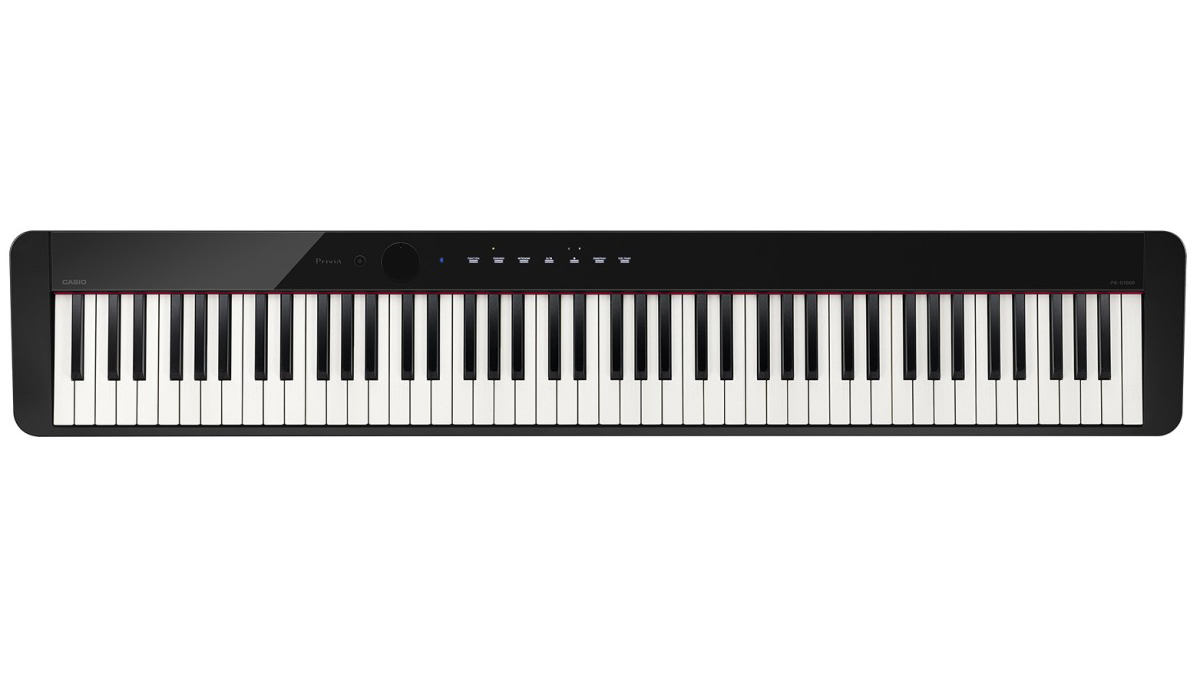Casio Privia PX-S1000 review
Our verdict on this affordable, portable keyboard

As a working jazz pianist in New York City, I never developed the technical savvy for electronics that many of my friends possess. I’m rather set in my musical ways, and I prefer to work mostly with acoustic instruments. So trying to find an affordable, portable keyboard with a convincing acoustic piano sound has been quite a challenge for me. That's why the new Casio Privia PX-S1000 is perhaps the most impressive keyboard I’ve ever played.
Overview
I used to think that in order to get an authentic piano sound, I would have to pay a large sum for a heavy keyboard by some of the more well-known instrument manufacturers. So I was shocked at how close Casio's new Privia PX-S1000 sounds and feels like a real acoustic piano. Its scaled hammer action has key surfaces textured with simulated ebony and ivory for an even greater level of piano authenticity, plus it has five touch sensitivity levels that can be adjusted to an individual's playing style. Weighing in at just 24.7 pounds (Casio calls it the world’s slimmest digital piano), the Privia PX-S1000 is an incredibly portable instrument, especially when paired with the optional SC-800 carrying case. I can even imagine carrying it to gigs like a backpack, which is great for travelling to shows on the crowded NYC subway!
Connections
The PX-S1000's back panel includes a USB port, an audio (stereo mini-jack) port, two 1/4 inch outputs, (stereo and mono). And while it is bundled with a sustain pedal, it also is compatible with Casio's SP-34 3 Pedal Sustain pedal to better simulate its acoustic counterpart. The PX-S1000's front panel also features two stereo mini-jack headphone ports. Power is supplied via the included AC adapter, or optionally by using six AA batteries that provide up to four hours of operation
- Display your lessons and music on one of the best ipads for musicians
- Recording? These are the best best MIDI keyboards you can buy
- Explore the synth world with our guide to the best synthesizers
- Get them started early with the best keyboards for beginners
Sounds and controls
When you look down at the PX-S1000's sleek top panel, you see only a power button and a volume knob. The rest of the top panel contains touch-sensitive controls that save space and unnecessary clutter. The Privia PX-S1000 contains 18 different "bread and butter" sounds, including numerous acoustic pianos, Rhodes and Wurlitzer-type electric pianos, vibes, string patches, organs, harpsichord, and acoustic bass. You can also layer and split these sounds. Digging into the soundbank, I found myself returning to the "Jazz Piano" patch often, as it reminded me of the classic piano sound on Bill Evan' seminal solo album Alone. The ’60s E Piano’ sounds like a Wurly with a built-in tremolo and I can see it working great in a variety of settings. For me, the various acoustic piano sounds like "Grand Piano Concert," "Bright," "Mellow," "Rock" and "Jazz" are the real stars here - they can cover any conceivable musical context when an authentic acoustic piano sound is needed. The PX-S1000 utilizes Casio’s AIR Sound Source, which creates realistic piano tones, expressive touch, and even features damper and string resonance effects. I was even surprised by the richness of the two included string patches.
Extras
The Privia PX-S1000 also includes a built-in metronome, plus a two-track MIDI recorder that can store one song on-board. The included "duet mode" feature splits the keyboard into two equal pitch ranges, which is great for educators teaching on one instrument. Casio has also linked the PX-S1000 with their exclusive Chordana Play app (available on Google Play or Apple's iTunes Store), which allows uses to adjust all of the PX-S1000's parameters remotely. It has 50 built-in songs with which you can practice. You can also download MIDI files for other songs to play along with. The PX-S1000's also features onboard stereo speakers that are so powerful I can imagine not needing a separate amplifier at many of my NYC jazz gigs. Lastly, the PX-S1000 lets you pair the speaker system through Bluetooth so you can play along with your favourite recordings.
Verdict
Every working pianist in a metropolitan area where space and portability are paramount should try Casio's Privia PX-S1000 for themselves. From its realistic piano sound and touch, to its extreme portability and modern connectivity, the PX-S1000 covers all the bases. At $600 street it's a steal, and it convinced an acoustic piano purist like me of the wonders of digital instruments. I highly recommend it!
Get the MusicRadar Newsletter
Want all the hottest music and gear news, reviews, deals, features and more, direct to your inbox? Sign up here.









